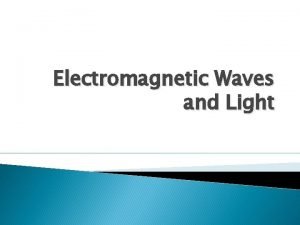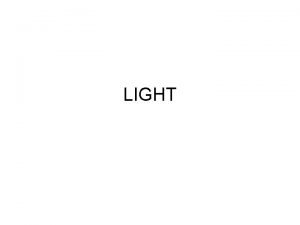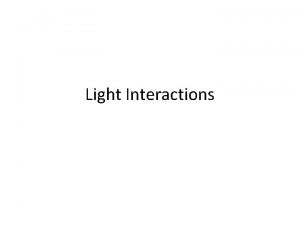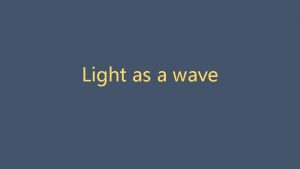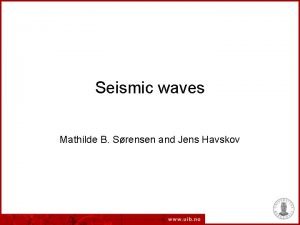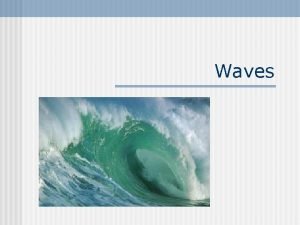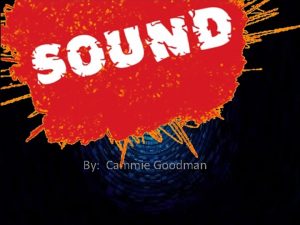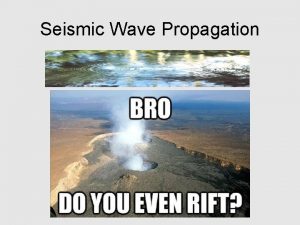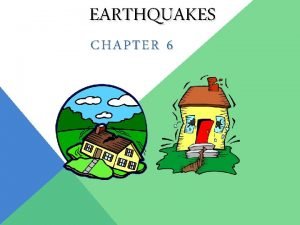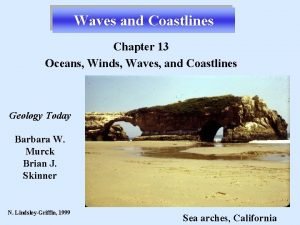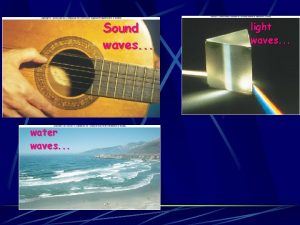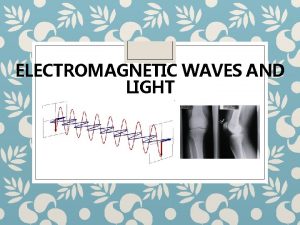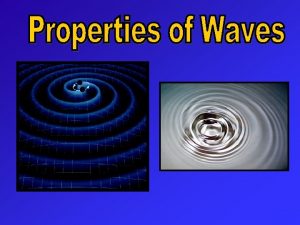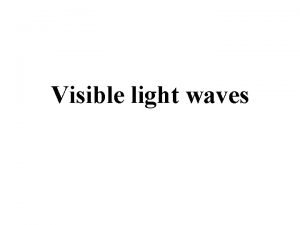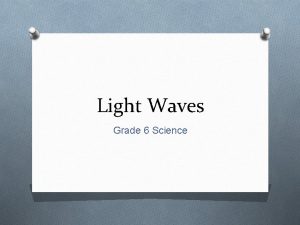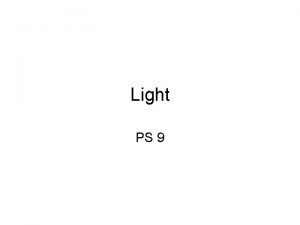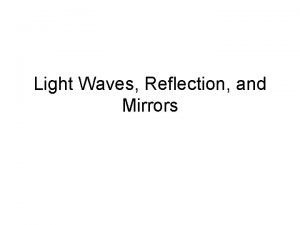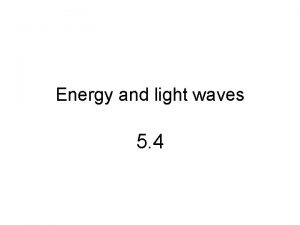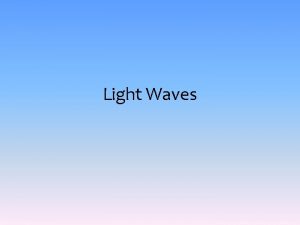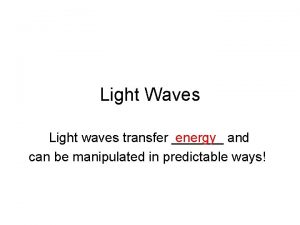Light Waves What is Light n Light is
































- Slides: 32

Light Waves

What is Light? n Light is the range of frequencies of the electromagnetic spectrum that stimulate the retina of the eye.

Light & Matter n n n Transparent (Glass): Materials that allow light to pass through without distorting images. Translucent (Cloudy Glass): Materials that allow light to pass through them, but do not allow them to be seen clearly. Opaque (Brick): Material in which all light is absorbed or reflected. Not is transmitted through.

Reflection and Absorption of Light and Color n The color observed by any object is the same as that not absorbed by the object. For example, a red block will absorb all colors of the EM visible light spectrum except for red. n How does this apply to the clothes we wear?

Continuous Waves n n n When a wave impacts a boundary, some of the energy is reflected, while some passes through. The wave that passes through is called a transmitted wave. A wave that is transmitted through a boundary will lose some of its energy. n n n Electromagnetic radiation will both slow down and have a shorter wavelength when going into a denser media. Sound will increase in speed when transitioning into a denser media. Speed of Light in different mediums

Continuous Waves – Higher Speed to Lower Speed n Note the differences in wavelength and amplitude between of the wave in the two different mediums Transmitted Wave v 2 Displacement Incident + Reflected Wave -v 1 Boundary Higher speed Lower speed Longer wavelength Shorter wavelength Note: This phenomena is seen with light traveling from air to water.

Continuous Waves – Lower Speed to Higher Speed Note the differences in wavelength and amplitude between of the wave in the two different mediums Incident + Reflected Wave Transmitted Wave v 2 -v 1 Displacement n Boundary Lower speed Higher speed Shorter wavelength Longer wavelength

Law of Reflection n The angle of incidence with respect to the normal is equal to the angle of reflection.

Specular & Diffuse Reflection n n Light incident upon an object with a smooth surface will create specular reflection. Light incident upon an object with a rough surface will create diffuse reflection.

Refraction of Light n n When light travels through a surface between two different media, the light will be refracted if the angle of incidence is greater than zero. If light is passing into a more dense media, it will bend towards a normal with the boundary.

Law of Refraction (Snell’s Law) n The ratio of the sine of the angle of incidence to the angle of refraction is a constant. n 1 sin 1 = n 2 sin 2 n Where: n 1, n 2 = index of refraction 1 = Angle of incidence 2 = Angle of refraction Note, the incident ray will always bend towards the normal when transitioning from a material with a lower index of refraction to one with a higher index of refraction. www. sol. sci. uop. edu

Speed of Light and the Index of Refraction n n The index of refraction, by definition, is the ratio of the speed of light in a vacuum to the speed of light in a substance. The index of refraction is always greater than 1.

Total Internal Reflection n n When the angle of incidence is such that the angle of refraction is equal to 90 o, the critical angle ( c) has been attained. All rays will be reflected internally at all angles greater than this angle. c = sin-1 (n 2/n 1) n n n Note: Internal reflection can only occur if n 2 < n 1. Internal Reflection (Use PHET) Application – fiber optic cable 2 1 1 2 www. micro. magnet. fsu. edu

Homework: Light I: Chapter 16 16, 18, 31, 32, 33, 41 16. Wavelength decreases as freq inc. 18. Screen B has ¼ the illumination of Screen A 31. 7 x 10 E-7 m 32. d = vt = 3 E 8 m/sec * 1. 28 s = 3. 84 E 8 m 33. d = vt d/v = t = 1. 5 E 8 km/3 E 8 m/sec = 1. 5 E 11 m/3 E 8 m/sec = 500 sec 41. d = vt = 3 E 8 * 0. 1 s = 3 E 7 m = 3 E 4 km. Since we are talking about a round trip time, a

Reflection Lab Angles Angle 1 Angle 2 Angle 3 Angle 4 Angle 5 Angle 6 A 10 50 15 25 20 30 B 30 20 45 25 35 30 C 55 40 30 10 35 45 D 45 65 50 40 10 55 E 40 55 45 60 50 30 F 60 50 65 45 30 60 G 20 30 60 45 55 15 H 50 20 40 60 10 30

Have you ever seen this?

Mirages can happen at any time of the year, but they are more commonly seen during the summer due to the hotter temperatures. The temperature difference between the layers of air is more important to the formation of a mirage than the actual temperature. The greater the difference in temperature the greater the bending effect.

Science (cont. ) There are two types of mirages. Superior and inferior mirages. Mirages are caused by light rays passing through a layer of hot air near the surface. This causes a bending effect. When the light rays are refracted a mirage is created.

Light Passing Through Glass Reflected Ray Air Glass Refracted Ray θ 2 θ 4 θ 3 θ 1 Incident Ray Note: 1 = 4 2 = 3 The light exiting the glass is parallel to the light entering it.

Start Period 1 here

Sunset is an illusion

Light II Chapter 17 p. 410 5, 6, 8, 10, 11 5. Angle of incidence is greater than angle of refraction 6. Angle of incidence is less than angle of refraction. 8. index of refraction times sine of angle of incidence = index of refraction times sine of angle of refraction 10. Angle of incidence that produces an angle of refraction whose sine is 90 degrees. 11. Total internal reflection.

Chromatic Dispersion n n When white light enters a medium, the different wavelengths that comprise the light will travel at different speeds. If the angle of incidence is greater than zero, the wave will exhibit chromatic dispersion. Note: The shorter the wavelength, the greater the bending. What happens to the frequency? n NOTHING www. physics. uiowa. edu

Diffraction of Light n When a wave front is incident on a barrier with an opening, the wave will spread out after crossing the barrier. This process is called diffraction. n n Diffraction is an interference phenomena. As the slit becomes narrower, the amount of diffraction will increase. As the wavelength of light increases, the amount of diffraction will increase. Diffraction

Is light a Wave? n Young Double-Slit Experiment: n n n The wave properties of light were first demonstrated by Thomas Young in 1801. Showed that light undergoes interference in and diffraction in much the same way that water and sound waves do. Used a source of monochromatic light so that only one wavelength was chosen. Also used light with no phase difference.

Young Double-Slit Experiment Huygen’s Wavelets www. src. wits. ac. za

Young Double Slit Experiment www. hyperphysics. phy-astr. gsu. edu

Young Double Slit Experiment (delta) = r 2 – r 1 n If r 2 – r 1 is equal to some multiple of , then the image on the screen will be a maximum (constructive interference). n If we assume that D is very big and r 1 and r 2 are parallel, then the angle between them will be . = d sin r 2 or m = d sin r 1 d D

Young Double Slit Experiment n n To determine the distance y between the central and first maximum, we will again assume that D is very large compared to y or d. From the diagram, we see that tan = y/D However, for small angles of , tan = sin Therefore, we r 2 can substitute y y/D for sin r 1 and get: d D

Young Double Slit Experiment n What are the implications of the formula? n n As wavelength ( ) and distance (D) to the screen increases, the distance between maximums increases. As the distance between slits (d) increases, the distance between maximums decreases.

Key Ideas n n Transverse waves such as electro-magnetic radiation do not require a medium. Light Waves travel at different speeds in different mediums. It slows down when going from air to a liquid or solid. Waves can interfere with one another resulting in constructive or destructive interference. The law of reflection states that angle of incident wave equals the angle of the reflected wave.

Key Ideas n n Snell’s Law / Law of Refraction: A wave will bend toward the normal when transitioning from a media with a low index of refraction (e. g. air) to a media with a higher index of refraction. Total internal reflection occurs when the angle of incidence is greater than the critical angle. Consequently, no light will escape. Diffraction is the spreading out of a wave when it encounters a barrier. Thomas Young’s double slit experiment showed that light has wave properties similar to water and sound.
 Light is an electromagnetic wave true or false
Light is an electromagnetic wave true or false What are constructive waves
What are constructive waves Mechanical waves and electromagnetic waves similarities
Mechanical waves and electromagnetic waves similarities Seismic waves are mechanical waves
Seismic waves are mechanical waves What type of waves are sound waves? *
What type of waves are sound waves? * Mechanical waves vs electromagnetic waves
Mechanical waves vs electromagnetic waves Example of mechanical wave
Example of mechanical wave Compare and contrast p waves and s waves using venn diagram
Compare and contrast p waves and s waves using venn diagram Whats a reflected sound wave
Whats a reflected sound wave Mechanical and electromagnetic waves similarities
Mechanical and electromagnetic waves similarities Mechanical waves and electromagnetic waves
Mechanical waves and electromagnetic waves Mechanical waves and electromagnetic waves venn diagram
Mechanical waves and electromagnetic waves venn diagram What is a semiconductor used for
What is a semiconductor used for Surface waves and body waves
Surface waves and body waves What is a rainbow
What is a rainbow Into the light chapter 22
Into the light chapter 22 Light light light chapter 22
Light light light chapter 22 Light light light chapter 23
Light light light chapter 23 Light waves
Light waves A lens that bends light waves inward
A lens that bends light waves inward Electromagnetic soectrum
Electromagnetic soectrum Opaque materials
Opaque materials Do light waves transfer energy
Do light waves transfer energy Materials that block light
Materials that block light Put out the light and then
Put out the light and then Membrane-bound organelles
Membrane-bound organelles The bouncing off of light
The bouncing off of light Thereforw
Thereforw Standing waves
Standing waves How are sound waves like ripples in a pond brainpop
How are sound waves like ripples in a pond brainpop Seismic waves
Seismic waves What are the factors of earthquake
What are the factors of earthquake Waves
Waves


















